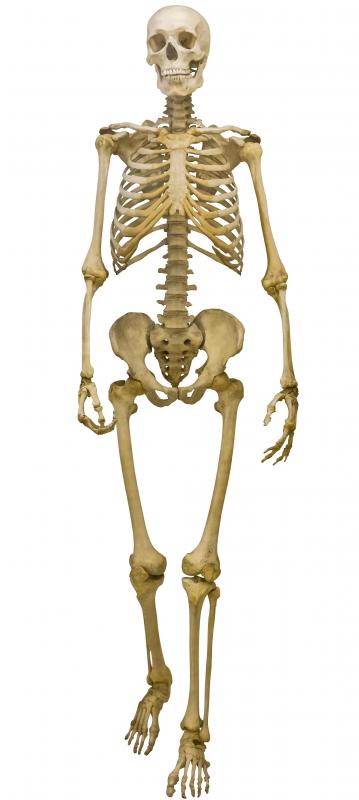At TheHealthBoard, we're committed to delivering accurate, trustworthy information. Our expert-authored content is rigorously fact-checked and sourced from credible authorities. Discover how we uphold the highest standards in providing you with reliable knowledge.
How Many Bones are in the Human Skeleton?
There are about 206 bones in the human skeleton. Interestingly, however, infant skeletons have even more. The human skeleton of a newborn consists of about 300 bones, but many of them fuse together later. The bones of the human skeleton are separated into several different parts of the body, including the skull, the vertebral column, the thoracic part of the skeleton, and the bones of the upper and lower limbs. The skeleton has very important roles in the human body, including stabilizing the body, supporting body tissues and organs, and producing blood cells.
The skull accounts for 22 bones of the human skeleton. The skull is responsible for protecting and supporting the brain as well as facial tissues. Some of the bones that make up the human skull also play an important role in the way human beings hear. Eight of the bones of the skull are referred to as cranial bones while the other 14 are facial bones.

The human skeleton also consists of the bones of the vertebral column, which is sometimes referred to as the spinal column. The vertebral column includes about 33 bones that have an irregular shape and are referred to as vertebrae. Seven of these bones are referred to as cervical vertebrae, 12 of them are called thoracic vertebrae, and five are called lumbar vertebrae. The sacrum, which is shaped similarly to a triangle, is fused in adults, but consists of four or five bones in children. The coccyx, which is also called the tailbone, consist of three to five bones that are fused in adult humans.

The thoracic part of the human skeleton, which is often referred to as the rib cage, consists of about 24 ribs that are in pairs. They include true ribs, which are connected to the spine and the sternum, which is also called the breastbone. False ribs are also found in this section and are connected to the spine and the lowest of the true ribs, and floating ribs are connected to the spine in the back but nothing in the front. The bones of the thoracic region help protect a person’s internal organs.

The human skeleton also includes the upper and lower limb bones. The upper limb bones include about 64 bones and play a critical role in the ability of the body to move. The lower limb bones, of which there are 62, are also important for movement and the support of the reproductive organs.
AS FEATURED ON:
AS FEATURED ON:















Discussion Comments
I learned about the number of bones in sixth grade. I remember exactly the day because after the presentation we had, it was a special day about health and science, they asked some review questions. One of them was "Does the child human body have more or less bones than the adult human body?" Everyone else said less, and I raised my hand and said more.
I was really proud I got it right, because it meant I listened. It also makes more sense when you think about it, because I don't see how our bones could somehow increase in number when we got older, unless we broke some.
I remember learning about this in school and thinking it was really interesting that our bones fuse together as we age; it just seems like such a smart natural way to strengthen the human skeleton bone by bone. I think it also serves as a good way to think about the importance of getting enough calcium and other essential nutrients, to make sure that fusion happens correctly.
Post your comments